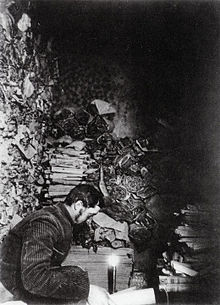- Tibetan Annals
-
Part of a series on Tibetan Buddhism
History Timeline · Related-topics Schools Nyingma · Kagyu · Sakya · Gelug · Bön · Jonang Key concepts Three marks of existence · Skandha · Cosmology · Saṃsāra · Rebirth · Bodhisattva · Dharma · Dependent origination · Karma Major figures Gautama Buddha · Padmasambhava · Je Tsongkhapa · Dalai Lama · Panchen Lama · Lama · Karmapa Lama · Rinpoche · Geshe · Terton · Tulku Buddhahood · Avalokiteśvara · Four stages of enlightenment · Tantric yoga · Paramitas · Meditation · Laity Changzhug · Drepung · Dzogchen · Ganden · Jokhang · Kumbum · Labrang · Mindroling · Namgyal · Narthang · Nechung · Pabonka · Palcho · Ralung · Ramoche · Sakya · Sanga · Sera · Shalu · Tashilhunpo · Tsurphu · Yerpa Chotrul Duchen · Dajyur · Losar · Monlam · Sho Dun Texts Kangyur · Tengyur · Tibetan canon · Mahayana sutras · Nyingma Gyubum Sand mandala · Thangka · Ashtamangala · Tree of physiology Outline · Comparative studies · Culture · List of topics · Portal
The Tibetan Annals, or Old Tibetan Annals ("OTA"), are composed of two manuscripts written in Old Tibetan language found in the early 20th century in the "hidden library", the Mogao Grottoes near Dunhuang, which is believed to have been sealed in the 11th century CE. They form Tibet's earliest extant history.[1]
Contents
Discovery
An enormous number of early manuscripts in a variety of languages were collected by A. Stein and P. Pelliot at the famous sealed-up Library Cave (no. 17) of the Mogao Grottoes and sent back to London and Paris respectively. Among these Dunhuang manuscripts, The Tibetan Annals (or "Tibet’s First History") were found along with the "Old Tibetan Chronicle", which was probably compiled between 800-840 CE.[2]
The manuscript designated IOL Tib J 750 in the British Library in London and Pelliot tibétain 1288 in the Bibliothèque Nationale in Paris are originally from the same original roll, 4.34 metres long and 0.258 metres wide.[3]
Contents
The Annals begin with a very brief account of the early events of the reign of Songtsan Gampo, the first Tibetan Emperor. From the time the Chinese Princess Wencheng arrived in 643 CE until Songtsan Gampo's death in 650 it is possible to accurately date the entries. It then gives a dated, year-by-year précis of important events from 650 to 764 CE. For example, in 763 CE, Tibetan soldiers captured Chinese Tang dynasty's capital of Chang'an for fifteen days during the An Shi Rebellion during which most of Tang Dynasty's military force was engaged in fighting the rebels.[4][5] Of course, annals continued to be recorded after this date but, unfortunately, only one or two other minor fragments have survived.[6] The Tibetan cyclic system dates are in much-faded red ink.[7]
These accounts, generally accepted as sober court records, provide a priceless view of Tibet in its early phase of expansion and establishment as a powerful empire. They also provide a valuable way of checking and dating events mentioned in later Tibetan and Chinese historical records.[8]
Neither the Annals nor the Chronicle make any mention of Buddhism in the reign of Songtsan Gampo.[9] However, the Chronicle does say that, during the reign of king Khri srong lde brtsan (Trisong Detsen) (r. 755-ca.797 AD.), "The incomparable religion of the Buddha had been received and there were viharas (monasteries) in the centre as well as the borderlands of the country."[10]
Footnotes
- ^ Dotson (2009), p. 9.
- ^ "Forward by Per Sørensen in (Dotson (2009), p. 1.)
- ^ Bacot, Thomas and Toussaint. (1940-1946), pp. 9-12.
- ^ Beckwith 1987, p. 146.
- ^ Stein 1972, p. 65.
- ^ Dotson (2009), pp. 12-13, 136-137.
- ^ Bacot, Thomas and Toussaint. (1940-1946), p. 9.
- ^ Choephel. (1978), pp. 44-46.
- ^ "Preface to the Asianart.com edition of this article." By Amy Heller, Jan 21, 2007.
- ^ Bacot, Thomas and Toussaint (1940-1946), p. 153.
References
- Bacot, Thomas and Toussaint. (1940-1946). Documents de Touen-houang relatifs a l'histoire de Tibet. J. Bacot, F. W. Thomas, Ch. Touissant. Paris. Libraire orientaliste Paul Geunther.
- Choephel, Gedun. (1978). The White Annals. Library of Tibetan Works & Archives Dharamsala, H.P., India.
- Dotson (2009). Brandon Dotson. The Old Tibetan Annals: An Annotated Translation of Tibet's First History. VÖAW, Austria. ISBN 978-3-7001-6102-8 (book); ISBN 978-3-7001-6712-9 (online edition).
External links
Categories:- Tibet
- History of Tibet
- Tibetan literature
- Historical documents
Wikimedia Foundation. 2010.


